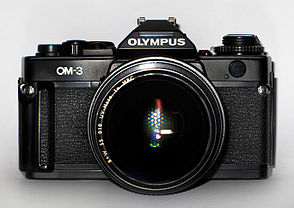Olympus OM-3
| Olympus OM-3 | |

|
|
| Type: | single-lens single-lens reflex camera |
| Production period: | 1983-1986 |
| Lens connection : | Olympus OM bayonet |
| Film format : | 35 mm (small picture) |
| Recording format : | 24 × 36 mm (small picture) |
| Viewfinder : | Pentaprism finder with Fresnel lens, diopter correction −3 - +1 |
| Viewfinder field: | 97% |
| Enlargement: | 0.84 times |
| Finder Ads: | Bar display of shutter speeds from 1 - 1/2000 s in 1/3 f-stop steps; Over and under exposure warning; "+/-" display for manual measurement; Lightning readiness; Exposure mode (spot / integral metering) |
| Operating modes: | Open aperture measurement, integral (center-weighted on shutter curtain - autodynamic), spot measurement using silicon measuring cells, 2% multi-spot measurement (maximum 8 points), high-key and low-key.
Button (in spot mode) |
| Film transport: | manual or motorized (winder / motor) |
| Exposure metering : | TTL open aperture measurement with lenses from the OM system |
| Measuring range: | EV 0 - 19 (at 100 ISO - with the Zuiko Auto-S 50 mm f / 1.4) |
| Correction : | +/- 2 f-stops in 1/3 steps |
| Closure : | mechanically controlled cloth closure (horizontal) |
| Shutter speed : | 1/2000 to 1 s, B. |
| Flash control: | manually |
| Lightning connection : | Standard ISO norm contact hot shoe (center contact) and 5-contact connection socket |
| Synchronization : | 1/60 s and longer |
| Power supply: | 2 × SR44 / LR44, test (LED and acoustic signal) |
| Dimensions: | 136 × 84 × 50 mm |
| Weight: | 540 g |
The Olympus OM-3 came on the market in 1983 and was built until 1986. It was the fully mechanical successor to the legendary Olympus OM-1 and the first camera of the new OM generation, which also included the Olympus OM-4 and later the Olympus OM-4 Ti and Olympus OM-3 Ti .
The OM-3 was the first fully mechanical camera with multi-spot measurement. Like its sister camera, the Olympus OM-4 (which was introduced with it in 1983, but only came onto the market in 1984), the OM-3 has an extremely sophisticated exposure metering system with multi-spot metering. In contrast to the OM-4, the OM-3 does not have the flash metering on the film level. The dosage of the flash light must be controlled manually or via a light sensor in the flash unit. In contrast to the OM-1, the exposure display in the viewfinder was no longer via a needle, but via an electronic LCD bar display.
The camera only needs battery power to measure the exposure and works without power. The OM-3 camera was designed for professional use and accordingly integrated into an extensive system of accessories. Due to the high price and because the Olympus OM-1n continued to be produced, the OM-3 never succeeded in entering the market successfully. This also explains the fact why the used price for an OM-3 is still relatively high and stable compared to other cameras.
equipment
Camera drives
- Motor Drive : The Olympus OM system has Motor Drive 1 and Motor Drive 2. Both allow film transports up to 5 frames / second. The Motor Drive 2 also offers motorized film rewind. The following energy sources are available for the Motor Drives: NiCd pack (15 V), battery handle (18 V, for 12 batteries or rechargeable batteries of size AA), control unit with mains connection.
- Winder : The Olympus OM system includes the Winder 1 and Winder 2. The Winder 1 only offers single picture recordings, while the Winder 2 also offers series pictures with up to 2.5 pictures / second. The winders do not offer automatic film rewind.
Camera back panels
The standard rear panel can be exchanged for the following rear panels:
- OM data back wall: a back wall for imprinting the date, time and exposure data
- Feature film magazines: Magazines 1 and 2 for film material for up to 250 exposures.
Focusing screens
16 interchangeable types of focusing screens, from the full focusing screen to the version with
Sectional view or microprism ring. The focusing screens are changed by the lens bayonet.
Flash units
In the Olympus OM system there are several flash units with different characteristics.
Remote release accessories
There are a number of accessories available for remote control of the OM-3, such as: B. Remote release cable, etc.
literature
- Olympus OM instruction manual (German), no date
Web links
- Commons : Olympus OM-3 - collection of images, videos and audio files
- Olypedia overview of the OM system [1]
